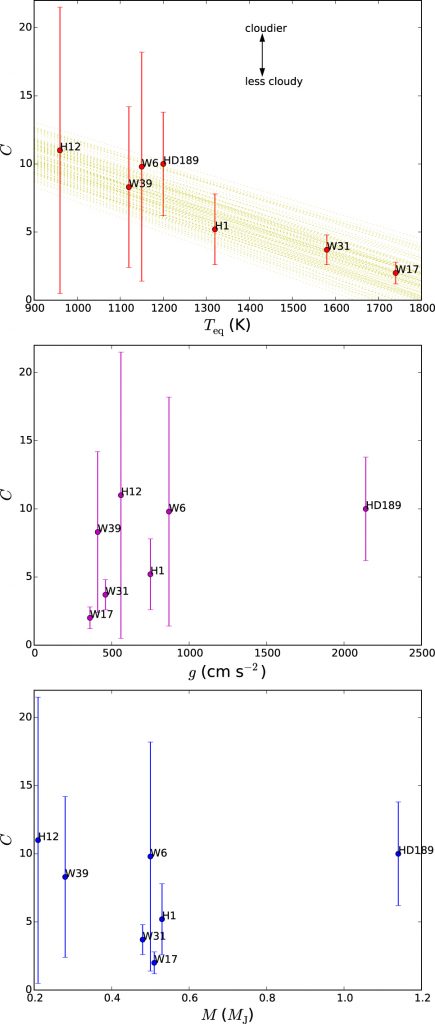Editor’s note: Astrobites is a graduate-student-run organization that digests astrophysical literature for undergraduate students. As part of the partnership between the AAS and astrobites, we repost astrobites content here at AAS Nova once a week. We hope you enjoy this post from astrobites; the original can be viewed at astrobites.org!
Title: A Cloudiness Index for Transiting Exoplanets Based on the Sodium and Potassium Lines: Tentative Evidence for Hotter Atmospheres Being Less Cloudy at Visible Wavelengths
Author: K. Heng
Author’s Institution: Center for Space and Habitability, University of Bern
Status: Published in ApJL, open access
Background
Most astronomers hate clouds, except for those who study them. Not only do clouds on the sky ruin observing nights, clouds on other planets obscure everything underneath, too. When observing extra-solar planets during transit, different atoms, molecules, and particles absorb light at different specific wavelengths, making the apparent radii of the planets change when viewed in different colors; this is known as transmission spectroscopy. Although it is a powerful tool to infer the atmospheric composition of exoplanets, these clouds often hinder our efforts to understand such alien worlds. With clouds present at high altitude, only the atmosphere above the clouds can be seen, and it is too thin to provide any spectral features (see this popular example). It turns out that a useful strategy for dealing with a problem is to avoid it. Valuable space telescope time could be saved if we could filter cloud-free objects from ground-based measurements. Today’s paper presents an index to quantify the degree of cloudiness for transiting planets.
Aim
The author first revisits how previous studies used the slope of transmission spectra caused by scattering (blue light is scattered more than red) to distinguish cloudy and dense atmospheres. Such dense atmospheres are more packed (with smaller scale height) and can produce flat spectra that are compatible with cloud-free hydrogen-dominated atmospheres. The author demonstrates that the scattering cross sections of gaseous molecules (e.g. hydrogen, nitrogen) and aerosols or condensates (cloud particles) have the same wavelength dependence. Measuring the spectral slope alone does not resolve the ambiguity between clouds and atmospheric composition. With this motivation, the author proceeds to find a cloudiness index that does not depend on the spectral slope.
Methods
Sodium has large cross sections so it can produce a prominent spectral line without being abundant. It is, in fact, the first extrasolar atmospheric detection on HD 209458b. In a clear, cloud free atmosphere, the difference in transit radii between the line center and wing of sodium can be theoretically calculated. By measuring the actual difference in transit radii between the line center and wing (Δ Robs), the author constructs a dimensionless index (C) for the degree of cloudiness as the ratio of Δ R and Δ Robs. For an entirely cloud-free atmosphere, Δ R equals to Δ Robs and C = 1. Very cloudy atmospheres have C ![]() 1. This cloudiness index is independent of the spectral slope, with the caveat that it is limited to planets with sodium or potassium line detections.
1. This cloudiness index is independent of the spectral slope, with the caveat that it is limited to planets with sodium or potassium line detections.

Figure 1: Cloudiness index plotted against equilibrium temperature (top), surface gravity (middle), planetary mass (bottom). The labels “W6,” “W17,” “W31,” “W39,” “H1,” “H12,” and “HD189” refer to WASP-6b, WASP-17b, WASP-31b, WASP-39b, HAT-P-1b, HAT-P-12b, and HD 189733b, respectively [Heng 2016].
Application to Data
Figure 1 plots the cloudiness index (C) versus equilibrium temperature, gravity, and mass of the planets. The uncertainty of the cloudiness basically stems from estimating the scale height with the equilibrium temperature in the calculation, which is larger for colder planets. An interesting trend of decreasing C with increasing equilibrium temperature (a proxy for stellar flux) is seen in the top panel. If the trend is real, it implies that more irradiated planets tend to be less cloudy. Future measurements of sodium lines at higher resolutions and for a larger sample will confirm or debunk the trend. If the trend holds, the author suggests that we can weed out cloudy objects for the detailed survey of JWST, to avoid spending lots of time (and money) for uninformative, featureless spectra.
About the author, Shang-Min Tsai:
I am a 3rd year PhD student at the University of Bern and part of the Exoplanets & Exoclimes Group led by Prof. Kevin Heng. We are developing various open-source tools to study exoplanets. I work on modelling of atmospheric chemistry and dynamics. When I am not coding or debugging, I enjoy basketball and playing board games.
